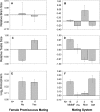Sexual selection and the evolution of brain size in primates
- PMID: 17183693
- PMCID: PMC1762360
- DOI: 10.1371/journal.pone.0000062
Sexual selection and the evolution of brain size in primates
Abstract
Reproductive competition among males has long been considered a powerful force in the evolution of primates. The evolution of brain size and complexity in the Order Primates has been widely regarded as the hallmark of primate evolutionary history. Despite their importance to our understanding of primate evolution, the relationship between sexual selection and the evolutionary development of brain size is not well studied. The present research examines the evolutionary relationship between brain size and two components of primate sexual selection, sperm competition and male competition for mates. Results indicate that there is not a significant relationship between relative brain size and sperm competition as measured by relative testis size in primates, suggesting sperm competition has not played an important role in the evolution of brain size in the primate order. There is, however, a significant negative evolutionary relationship between relative brain size and the level of male competition for mates. The present study shows that the largest relative brain sizes among primate species are associated with monogamous mating systems, suggesting primate monogamy may require greater social acuity and abilities of deception.
Conflict of interest statement
Figures


References
-
- Darwin C. The descent of man, and selection in relation to sex. London, UK: Murray; 1871.
-
- Dunbar RIM. Neocortex size and group size in primates: a test of the hypothesis. J Hum Evol. 1995;28:287–296.
-
- Dunbar RIM. The social brain hypothesis. Evol Anthropol. 1998;6:178–190.
-
- Dunbar RIM. The social brain: mind, language, and society in evolutionary perspective. Ann Rev Anthropol. 2003;32:163–168.
-
- Byrne RW, Whiten A. Machiavellian intelligence. In: Whiten A, Byrne RW, editors. Machiavellian intelligence II. Extensions and evaluations. Cambridge, UK: Cambridge University Press; 1997. pp. 1–23.
Publication types
MeSH terms
LinkOut - more resources
Full Text Sources

